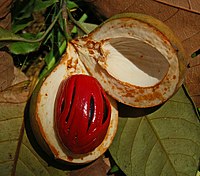
Photo from wikipedia
To achieve food security, it is necessary to increase crop radiation use efficiency (RUE) and yield through the enhancement of canopy photosynthesis to increase the availability of assimilates for the… Click to show full abstract
To achieve food security, it is necessary to increase crop radiation use efficiency (RUE) and yield through the enhancement of canopy photosynthesis to increase the availability of assimilates for the grain, but its study in the field is constrained by low throughput and the lack of integrative measurements at canopy level. In this study, partial least squares regression (PLSR) was used with high-throughput phenotyping (HTP) data in spring wheat to build predictive models of photosynthetic, biophysical, and biochemical traits for the top, middle, and bottom layers of wheat canopies. The combined layer model predictions performed better than individual layer predictions with a significance as follows for photosynthesis R2 = 0.48, RMSE = 5.24 μmol m–2 s–1 and stomatal conductance: R2 = 0.36, RMSE = 0.14 mol m–2 s–1. The predictions of these traits from PLSR models upscaled to canopy level compared to field observations were statistically significant at initiation of booting (R2 = 0.3, p < 0.05; R2 = 0.29, p < 0.05) and at 7 days after anthesis (R2 = 0.15, p < 0.05; R2 = 0.65, p < 0.001). Using HTP allowed us to increase phenotyping capacity 30-fold compared to conventional phenotyping methods. This approach can be adapted to screen breeding progeny and genetic resources for RUE and to improve our understanding of wheat physiology by adding different layers of the canopy to physiological modeling.
Journal Title: Frontiers in Plant Science
Year Published: 2022
Link to full text (if available)
Share on Social Media: Sign Up to like & get
recommendations!